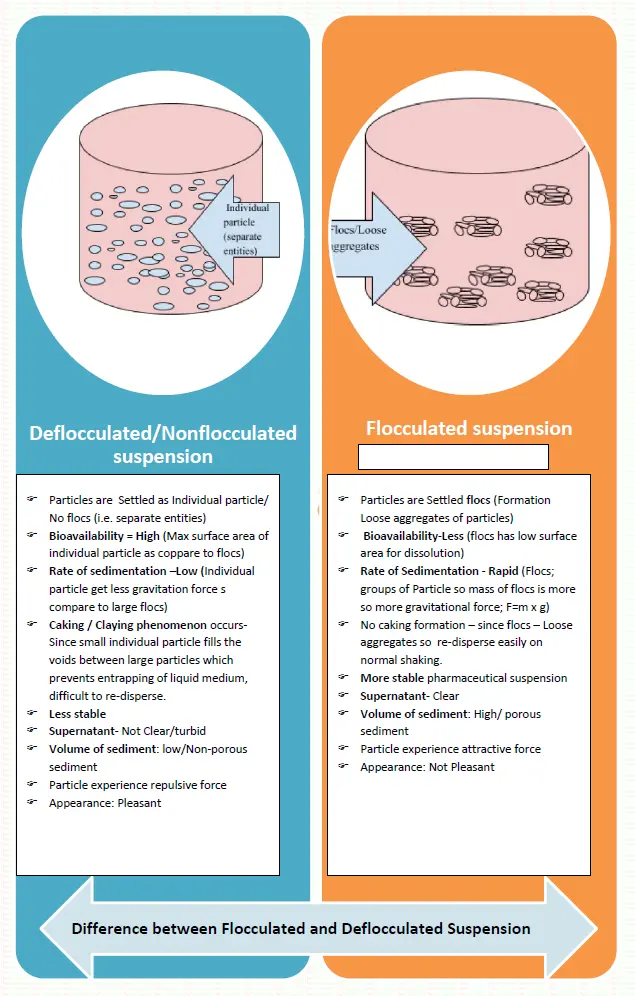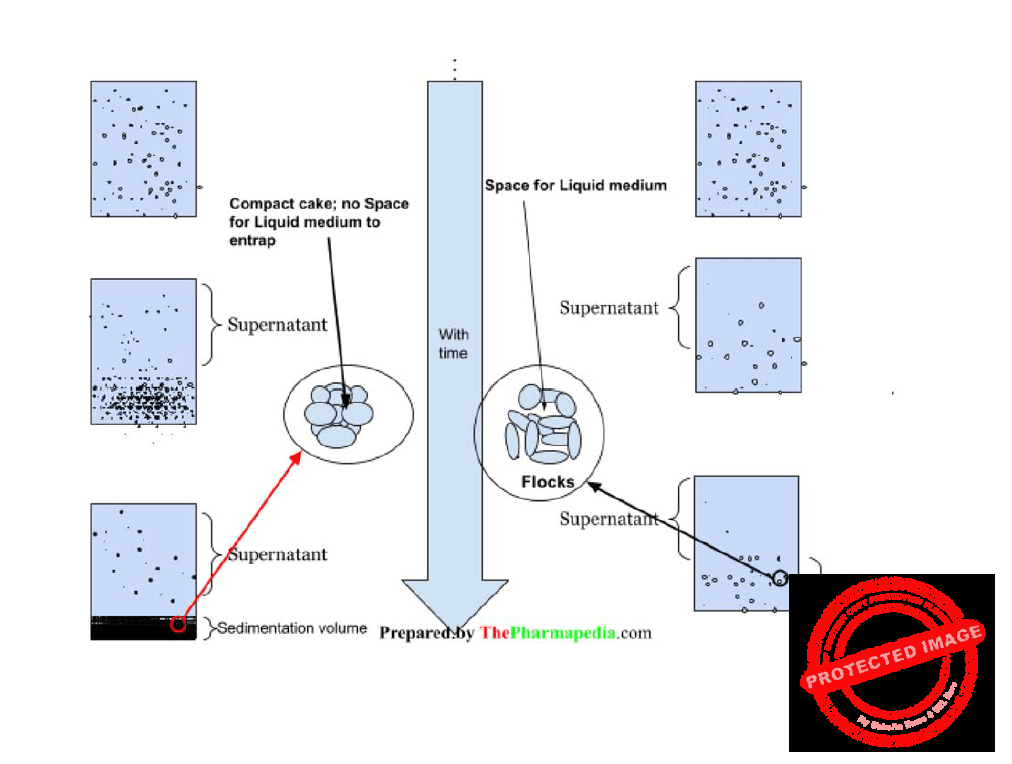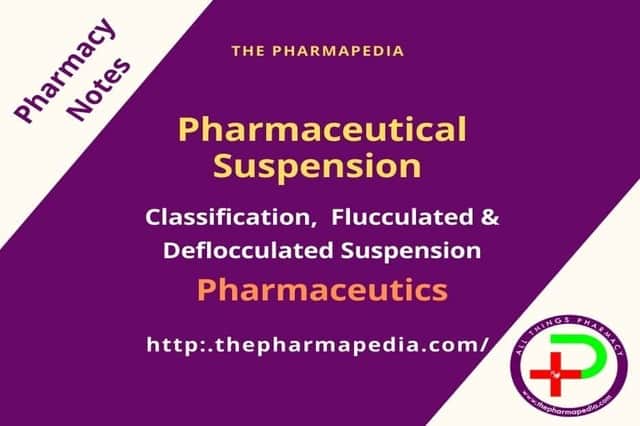Suspensions are a class of dispersed systems (Heterogenous systems) in which a finely divided solid is dispersed uniformly in a liquid dispersion medium. or A pharmaceutical suspension may be defined as a coarse dispersion of biphasic liquid dosage form containing finely divided insoluble material suspended in a liquid medium.
A pharmaceutical suspension is a coarse dispersion in which the internal phase (the active ingredient) is placed/distributed uniformly throughout the external phase/continuous phase.
- Internal phase consists – Insoluble solid particle size of range -0.5 – 5 micrometer ;
- External phase (suspending medium – generally aq. & some time may be organic or non-aqueous- Oil)
- Suspension dosage forms are given by the oral route, injected intramuscularly or subcutaneously, instilled intranasally, inhaled into the lungs, applied to the skin as topical preparations, or used for ophthalmic or otic purposes in the eye or ear, respectively.
Characteristics of Ideal Suspension
- Dispersed particle should not settle (Sediment rapidly);
- If sedimented – It should not form hard cake at the bottom of container & redispersed on moderate shaking.
- Viscosity of the suspension – is such that the product can be easily poured from the container
- if Viscosity is more :– sticky in oral cavity & difficult in shallowing
- if Viscosity is less:- pouring problem
- Pleasant odour, colour & palatability
- Physically, chemically & microbiologically stable.
- Parenteral ophthalmic sus-must sterile & Isotonic
- Opthalimic suspension (particle size max 10 micrometer)
- Good syringeability
- It should be physically,chemically and microbiologically stable
Formation of suspension are to be needed:
- When the drug is insoluble in vehicle
- To mask bitter test of drug (eg. chloramphenicol palmitate)
- To increase stability (water sensitive drug- dispersed into Nonaq. Phase)
- To sustained drug release(protamine zinc sulphate, procaine penicillin G)
Classification of Suspension

I. Based on the proportion of solid particles concentration:- Two Types
Diluted suspension
The dilute suspension contains 2 to10%w/v solid, Follow Stock’s law
Eg: cortisone acetate, predinisolone acetate
Concentrated suspension
Conc. suspension contains up to 50%w/v solid
Eg, zinc oxide suspension
II. Based on General classes:-
- Oral susp. – Paracetamol suspension, antacids, Tetracycline HCl,
- Externally applied susp. – calamine lotion
- Parenteral susp. – Procaine Penicillin G & Insulin Zinc suspension.
III. Based on the Electro-kinetic nature of solid particles:-
Suspensions can be divided into two groups as flocculated suspensions and deflocculated suspensions based on the electro-kinetic nature of solid particles that are suspended in the suspension.
Difference between Flucculated & Deflocculated Suspension

Flocculated suspension
A flocculated suspension is a suspension in which particles of the suspension has undergone flocculation. A flocculated suspension is composed of large aggregates (flocks) and this type of suspension will lead to a rapid rate of sedimentation.
Sedimentation is the settling down of aggregates or particles of suspension to the bottom of the liquid. Aggregation of particles makes large aggregates that can act as large individual particles. When these aggregates are settling down, a large number of particles are settling down. Then the rate of sedimentation is high. These aggregates are known as floccules. Floccules can sediment faster than smaller particles under the effect of gravity.
Deflocculated suspension
A deflocculated suspension is a suspension in which no flocculation has taken place. Hence, there are no floccules/aggregates. Here, single particles act as individual particles. When sedimentation occurs, these single particles settle. In a deflocculated suspension, dispersed particles exist as separated units. The rate of sedimentation is slow since smaller particles are settling slow rather than large floccules. The final sediment has a small volume than a flocculated suspension. Even after the formation of the sediment, the supernatant of this suspension will still have cloudiness. The formation of the sediment here is also called caking.

Deflocculated/Non-flocculated suspension
- Settled as Individual particles (separate entities)
- Bioavailability = High (Max surface area of the particle)
- Rate of sedimentation –Low
- Caking / Claying phenomenon occurs – No redispersion on shaking – since small individual particle fills the voids between large particles which prevents entrapping of liquid medium.
- Result in difficult to redisperse by agitation / shaking
- Less stable
- Supernatant- Not Clear/turbid
- Particle experience a repulsive force
- Appearance: Pleasant
Flocculated suspension
- Settled/Formation of Flocs (Loose aggregates) – Less Bioavailability
- Rate of Sedimentation –Rapid
- No caking formation – since flocs – Loose aggregates so re-disperse easily on normal shaking.
- More stable pharmaceutical suspension
- Supernatant- Clear
- Particle experience an attractive force
- Appearance: Not Pleasant
Advantage of Suspension
- Suspension can improve chemical stability of certain drug.
- E.g. Procaine penicillin G.
- The drug in suspension exhibits higher rate of bioavailability than other dosage forms.
- Solution > Suspension > Powder>Capsule > Compressed Tablet > Coated tablet
- Duration and onset of action can be controlled.
- E.g. Protamine Zinc-Insulin suspension.
- Suspension can mask the unpleasant/ bitter taste of drug.
- E.g. Chloramphenicol
Disadvantage of Suspension
- Physical stability like sedimentation and compaction can causes problems.
- It is bulky sufficient care must be taken during handling and transport.
- It is difficult to formulate.
- Uniform and accurate dose can not be achieved unless the suspension is packed in the unit dosage form.
Application of Suspension in Pharmaceutics
- Suspension is usually applicable for drug which is insoluble (or ) poorly soluble; E.g. Prednisolone suspension
- To prevent degradation of drug or to improve stability of drug; E.g. Oxy tetracycline suspension
- To mask the taste of bitter of unpleasant drug.E.g. Chloramphenicol palmitate suspension
- Suspension of drug can be formulated for topical application. e.g. Calamine lotion
- Suspension can be formulated for parentral application in order to control rate of drug absorption.E.g. penicillin procaine
- Vaccines as a immunizing agent are often formulated as suspension.E.g. Cholera vaccine
- X-ray contrast agent are also formulated as suspension. eg: Barium sulphate for examination of alimentary tract
Formulation of Suspension
Click here for the formulation of suspension


Comments are closed